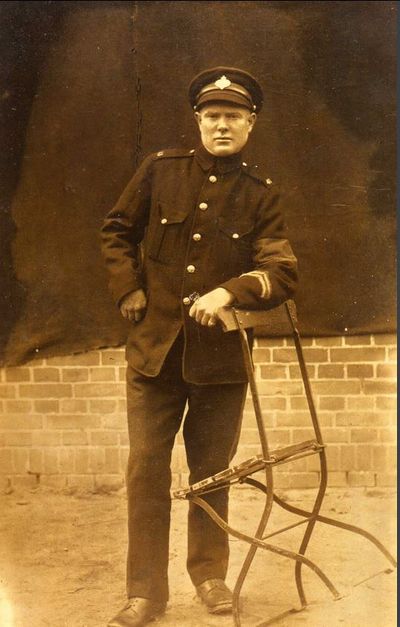John William King
From Our Contribution
 John King while a POW - photo Ancestry.com | |
| Personal Information | |
|---|---|
| Date of Birth | 27 Jan 1885 |
| Place of Birth | Jarrahdale, Western Australia |
| Death | 18 Aug 1964, aged 78 |
| Place of Death | Royal Perth Hospital, Perth, Western Australia |
| Age at Enlistment | 29 years, 11 months |
| Description |
5'8" (1.73m) tall ; 158lbs 71.668 kg ; fair complexion ; blue eyes ; fair hair ; scar on right thigh and on left breast |
| Occupation | Mill hand |
| Religion | Church of England |
| Address | King street, Gosnells, Western Australia |
| Next of Kin | Wife , Mrs Elizabeth Anne King |
| Military Information | |
| Reg Number | 5124 |
| Date of Enlistment | 6 Jan 1916 |
| Rank | Private |
| Unit/Formation | 16th Battalion, 16th Reinforcement, transferred to 48th Battalion, A Company |
| Date of Embarkation | 31 Mar 1916 ‒ 24 Apr 1916 |
| Ship Embarked On | HMAT A9 Shropshire |
| Date of Return | 3 Mar 1919 ‒ 10 Apr 1919 |
| Ship Returned On | HMAT A14 Euripides |
| Fate |
Prisoner of War 12 Oct 1917 Passchendaele Returned to Australia |
| Monument |
Gosnells Road Board Honour Roll The Australian Ex-Prisoners of War Memorial Ballarat, Victoria |
| Medals |
British War Medal Victory Medal |
Contents
[hide]Pre War
On 10 Feb 1909 John married Elizabeth Ann Scrivener at the No. 6 Mill at Jarrahdale. Elizabeth died 9 Sep 1975 in Royal Perth Hospital. Children were George William King (1909 - 1967); John Walter King (1911 - 2006); Lillian Emma King (1912 - 1982); Ruby Elizabeth King (1915 - 1986); and Mary Alice King (1920 - 2008).
War Service
John entered Blackboy Hill camp on 6 Jan 1916, and was allocated to the 16th reinforcement draft for the 16th Battalion, and he travelled with them to Egypt. On arrival in Egypt John was sent to the 4th Training Battalion before transferring to the 12th Training Battalion as a reinforcement for the 48th Battalion. On 7 Jun 1916 he embarked in Alexandria aboard HMT Huntspill for Marseilles, disembarking there on 14 Jun 1916, before transferring to the 48th Battalion in the field on 21 Jul 1916. His file contains a cover sheet for a Court Martial held 9 Sep 1916, with the notation that he was found Not Guilty. He faced two charges (1) When on active service leaving his post without orders from his superior officer; (2) When on active service an act to the prejudice of good order and military discipline.
On 29 Nov 1916 he was detached to the 4th Division Headquarters, and on 3 Dec 1916 he was attached to the 4th Division's Infantry School. On 29 Apr 1917 he was transferred to the 1st Anzac Corps School, and on 21 Jul 1917 to the 2nd Anzac Corps School. On 4 Aug 1917 he was charged with contravening the censorship regulations and awarded 14 day's Field Punishment No.2. (See notes.) On 4 Sep 1917 he was ill, seen by the 41st Casualty Clearing Station, transferred to the 6th Convalescent Depot in Étaples, and on his release on 22 Sep 1917 he reported to the 4th Division's Base Depot. On 6 Oct 1917 he rejoined the 48th Battalion just as they moved forward of Ypres to participate in the attack on Passchendaele.
Specifically the 48th Battalion was to attack German positions between Zonnebeke and Passchendaele Ridge in the most atrocious weather conditions. Of the 621 members of the battalion that participated in the attack, 372 were either killed, wounded or missing. John was one of the later category and it was sometime before the battalion learned that he had been captured when they were forced to concede the ground that they had gained. German records place the point of capture as the Ypres - Roules railway line and he was later interned at Limburg.
Repatriated to England on 14 Dec 1918, he was granted leave until 18 Jan 1919. On 22 Jan 1919 he was charged with being AWOL from 18 - 20 Jan 1919, forfeiting 6 day's pay. John was discharged by the 5th Military District on 9 Jun 1919 with a disability listed as deafness.
Post War
Electoral Roll entries: 1937 at Barton's Mill, mill hand; 1943 Ipsen street, Manjimup, Mill hand; 1949 - 1958 at 91 Jones street, Collie, retired.
Notes
Field punishment could be awarded by a court martial or a commanding officer for any offence committed on active service. There were two categories of field punishment. Field punishment No. 2 consisted of heavy labouring duties, and several hours a day shackled . All offenders awarded field punishment would march with their unit, carry their arms and accoutrements, perform all their military duties as well as extra fatigue duties, and be treated as defaulters